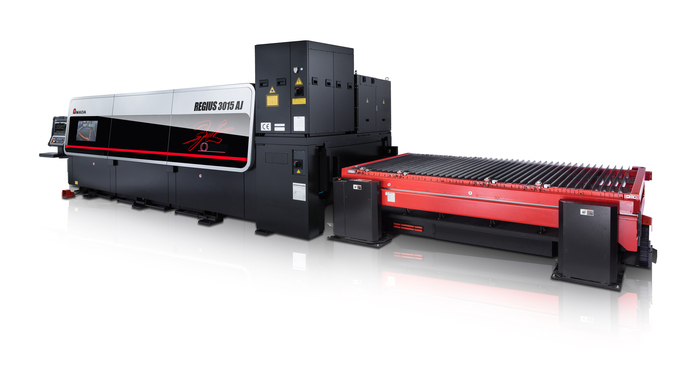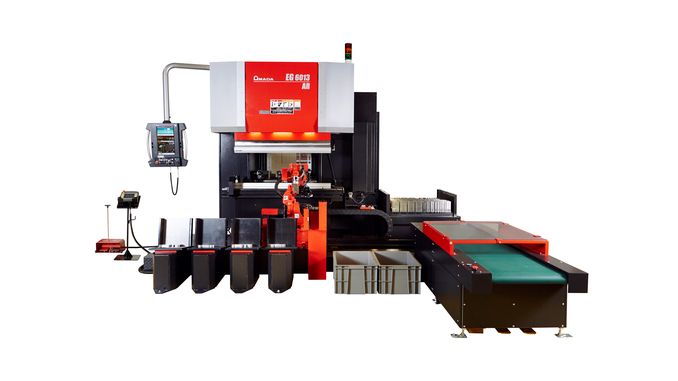
With beams and beams – Amada does not disappoint at this year’s Blechexpo: Not only new laser, bending and folding machines are presented, but also inner values, for more precision, quality, productivity, comfort andandand …
Cutting stainless steel and aluminum without compromise with the fiber laser
A new fiber laser generation with 4 kW laser power and only one laser module offers the possibility to cut demanding materials without compromise. For the first time, it has been possible to produce stainless steel and aluminum in particular with a cutting quality that is practically in no way inferior to that of a CO2 laser.
Cutting performance in a new dimension
With the Ventis-3015AJ 4 kW, Amada introduces a new laser cutting system that uses revolutionary flexible beam delivery and numerous patents to overcome previously existing limitations of fiber laser technology. With only 4 kW of laser power, it achieves a performance that is usually attained by 6- or 8-kW systems.
In a new process, the machine can oscillate the laser beam in the kerf according to predefined patterns. This not only leads to significantly increased cutting speeds, but also enables an absolutely right-angled cut at the same time. According to Amada, the surface roughness achieved is unparalleled in the fiber laser sector and is comparable in quality to that of a CO2 laser. At the same time, the otherwise common fiber laser burr can be virtually eliminated.
Always with the highest beam quality through all materials
For discerning clients, flawless quality of a consistent standard is particularly important. The Amada Ventis-3015AJ solves this problem by continuously maintaining the laser mode. Therefore, the machine achieves exceptionally high quality results for a 4 kW fiber laser. The beam parameter product (SPP) is consistently ≤ 0.9 mm-mrad. Due to the different pendulum patterns of the laser beam, every task can be solved individually, thin as well as thick sheet metal can be cut with maximum speed and at the same time with the highest quality.
Further savings as a side effect
In addition to the high performance of the Amada Ventis-3015AJ, it offers an equally high level of resource conservation. The significantly higher processing speed also results in a savings effect per manufactured part, as the energy and gas required could be significantly reduced once again.

Fastest laser cutting system in Amada to date
Not only will the highly specialized Regius-3015AJ CNC fiber laser cutting system be the fastest in Amada’s portfolio, the laser cutting system will also ensure that it constantly monitors and automatically controls itself through intelligent features and functions integrated into the system. It thus achieves a new maximum level of productivity and economic efficiency – with simplified operation and increased availability at the same time.
The Regius-3015AJ scores with linear drives in all three main axes, achieving outstanding precision and an ultra-fast point-to-point positioning speed of 340 m/min. This is supported by the new Amada laser head control system, which makes real-time decisions about the retraction height of the head. For example, in the case of two piercing points close to each other, the laser head is not simply retracted to a certain height, but remains as close as possible to the sheet, thus reducing the cycle time. Combined with the outstanding speed of the linear drives, the Regius-AJ thus achieves fast point-to-point movement.
In recent tests comparing the new Regius-3015AJ with the company’s fastest laser cutting system to date, the FOL-AJ, the benefits were clear. By combining the linear drive technology with the new intelligent laser head control, the Regius-AJ was a full 14 percent faster than the FOL-AJ when cutting an identical box plan from 1 mm thick stainless steel at the same output power.
Automatic condition monitoring
The second important technology that the Regius-3015AJ boasts is the new “Laser Integration System” (LIS), which offers functions such as automatic inspection and automatic restoration of cutting readiness after a possible collision.
Automatic inspection includes technologies such as the “i-Nozzle Checker” to assess any nozzle damage. When the nozzle needs to be changed, it is done automatically by the Regius-AJ’s 16-station nozzle changer, eliminating the need for subjective testing by the operator.
Another feature of the i-Nozzle Checker is the automatic alignment of the laser beam to the nozzle, if required, and the beam condition check is also performed automatically to ensure that the focus is optimally set.
Another feature of the system’s numerous automatic inspection functions is the i-Optik sensor, which monitors the protective glass for dirt and other abnormalities and alerts the operator as soon as a change is required.
Intelligent process monitoring system
The Regius-AJ’s new i-Process Monitor system is also part of the LIS and checks the laser beam, or more precisely the resulting reflections, in real time, preventing any processing errors before they occur.
Automatic cutting head recovery after a collision is another impressive feature of the Regius-3015AJ, which uses the i-Optik sensor and i-Nozzle Checker to ensure that processing can continue reliably as quickly as possible. Systems that do not have this feature simply stop in the event of a collision and only issue an alarm, leaving valuable production time unused.
Automatic beam adjustment
The third integrated technology of the Regius-AJ is the already well-known Amada beam adjustment, which automatically generates an optimized beam shape for any material and thickness. Users can thus implement high-quality, process-stable cuts in all sheet thicknesses (from extremely thin to 25 mm mild steel, stainless steel and aluminum) and cover the entire machining range with just one lens.
The Regius-AJ scores further convincing plus points with its AMNC-3i-Plus control system and the camera-supported i-CAS system, which greatly simplifies the processing of sheet remnants. For example, if an extra part needs to be cut, the Regius-AJ’s i-CAS camera can display the entire work area and show any remaining piece on the AMNC 3i Plus control. The corresponding part can then be selected from the library, positioned, rotated or even copied before cutting of the remaining piece begins.
Another new feature of the AMNC 3i Plus is Amada’s V-remote remote control, which allows the user to access the control remotely and, for example, check the status or history of the machine. New jobs can thus also be added to the schedule (remotely) according to the preset access priorities.

Automatic tool change for the middle class
Over 300 ATC (Automatic Tool Changer) press brakes are installed throughout Europe and more than 1000 worldwide. Now Amada is expanding the product range with ATC technology for the mid-range. Until now, the offer only referred to high-end press brakes such as the HG-ATC and its predecessor HD-ATC. With the new HRB-ATC mid-range model, Amada is responding specifically to market demand. The HRB-ATC is equipped with original Amada tools.
The HRB-ATC from Amada has an automatic tool changer with the same capacity as the high-end model HG-ATC. The new machine is supplied with an individually configured tool package with original Amada tools according to customer requirements. It should be emphasized that the HRB-ATC is compatible with Amada AFH/Promecam standard tool sets. This allows any existing tooling from an Amada manual press brake to be used with the HRB-ATC.
Press brake with many advantages
An Amada press brake with ATC offers many advantages: With the use of the ATC, the set-up time can be reduced by up to 80 percent compared to manual set-up by an operator. A clear advantage for job shops or contractors who make multiple tool layout changes daily. In addition, the operator can perform other tasks simultaneously while the ATC is operating, increasing overall efficiency.
The fast set-up potential of the ATC makes the new press brake particularly interesting for those who produce small batches. Contract manufacturers benefit particularly here. Production advantages also result from the rotation option – all punches can be installed positively or negatively. Another advantage: If special tools or lengths are required for production that the ATC cannot load itself, the hydraulic clamping system for punches and dies enables manual installation in the shortest possible time.
Automatic crowning, automatic angle measurement
Other important machine features include the standard automatic crowning – the compensation of deflections in the upper and lower press beam. This standard equipment contributes enormously to the increase in precision.
The optional, active automatic angle measurement Bi-S ensures highly accurate bending results, even with varying material thicknesses and properties. The use of this system results in significantly fewer rejects. An option that is particularly useful for companies that produce small batches or process expensive materials.
Also available as an option is the automatically moving foot pedal, which automatically positions itself at the current bending station, thus significantly increasing ergonomics and productivity.
Numerous new functions for easier operation
The AMNC-3i control with large touch screen includes a number of innovative features, including the new “Lite Mode”. In fact, Lite mode offers simplification of the HMI, which in turn speeds up the operation of the controller and simplifies the introduction of new employees.
The new HRB-ATC press brake has been installed as a demo machine in various European Amada branches since July 2021. Initially, the 100-ton/3-m press brake will be available, followed later in the year by the larger 220-ton/4-m press brake.

Versatile solutions with automatic robot technology
Based on many years of experience with automatic bending, Amada presents new and further developed bending cells: the EG-6013 AR has an extremely flexible automatic robot system and innovative sensors in the back gauge. The HG-1003 ARs and HG-1303 Rm bending cells will show visitors to Blechexpo the advanced state of development in solutions for automated bending.
– Smart processing: The AMNC3i controller offers a user-friendly design that makes it easy to operate. Thanks to the built-in CAM technology, the robot moves automatically and no instructions are required.
– Even small parts are bent with high speed and high precision: new gripper for small/complex parts and a newly developed robot optimized for bending.
– Environmentally friendly: new servo drive system with higher performance potential and lower energy consumption
– Space-saving: a single robot handles both tool changing and workpiece machining, all in a compact design that makes the system easier to use and saves space.
Integration in sheet metal processing
It is a further advance in the processing of sheet metal parts: The expertise that has gone into Amada’s software no longer refers only to the processing of production steps for individual parts. Now the software is able to predict all machining steps from start to finish. To achieve a better result, the entire machining program is reversed (assembly → welding → bending → cutting).
Amada:
The Amada Group is one of the world’s leading manufacturers of sheet metal working machines. Amada GmbH offers a comprehensive range of cutting, bending, welding, punching and laser technologies. Modular automation components, software applications and a wide range of tools complete this offer. In addition, Amada offers its customers a wide range of services. The Amada Group was founded by Isamu Amada in Japan in 1946. The German subsidiary Amada GmbH has been in existence since 1973.
Web:
www.amada.de



